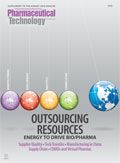News
Article
Pharmaceutical Technology
Effective Technology Transfer and Validation Strategies with CMOs
Author(s):
The success of a pharmaceutical manufacturing transfer from one facility to another requires detailed operational plans, attention to detail, and coordination between all parties. \
Ted Horowitz/getty images

Technology transfer occurs when a pharmaceutical company moves its product from an existing manufacturing site to a new manufacturing site. This transfer can happen from one process train to another process train within the same building, from one facility to another facility, from one building to another on the same campus, or to a contract manufacturing organization (CMO).
At every stage, a detailed operational plan and cooperation among all parties involved are required to avoid cost overruns and delays and ensure regulatory approval of the manufacturing process. From the perspective of the drug license holder, a successful technology transfer begins with due diligence.
Due diligence essentials
The goal of due diligence is to be fully aware of all issues that may impact the manufacturing of a pharmaceutical product. CMOs receiving a client’s new drug product for manufacturing must have a thorough understanding of the processes, quality control, quality assurance, regulatory affairs, and logistics related to the manufacture of a drug product.
During this process, all aspects of the project-for example, ensuring that analytical methods are current with today’s pharmacopeia standards and are based on the product’s formulation-are double-checked. The due diligence process should include the following steps:
- Ensure that the supply of the API and key excipients are of identical grade and function
- Identify materials that may be hazardous to employees or the environment
- Reveal any issues with the product
- Include a review of all development reports
- Analyze the development of process parameters
- Identify specific equipment needs
- Review any product complaints
- Uncover potential manufacturing issues
- Identify any FDA 483 observations issued for manufacturing or testing
- Explain any documented commitments made to regulatory agencies that need to be completed.
Assessing manufacturing feasibility and changes
Chemical processes involved in manufacturing pharmaceuticals are often exacting; small changes in humidity, climate, water source, or equipment can have a noticeable impact, as can changes in the process (e.g., changing from scooping to gravity feed), suppliers of raw materials, or even personnel training.
Ideally, a technology transfer begins by assessing the original manufacturer’s information, from raw materials through critical process parameters, followed by equipment evaluations according to scale-up and post-approval change (SUPAC) guidelines. The FDA’s SUPAC guidelines identify the types and specifications of equipment available for different pharmaceutical manufacturing functions [SUPAC: Manufacturing Equipment Addendum] (1). For example, blending equipment can be organized into several different classes, from V-blenders to ribbon blenders to bin blenders; SUPAC charts allow efficient comparison between the various classes.
Transfer protocols should challenge critical steps and machine differences. It may, for example, be necessary to develop new operating ranges for the product, in which case one or more batches may be required. The more rigorously a process is challenged in the feasibility stage, the more robust that process will be moving forward. A strong process means reproducible quality, which in turn means fewer rejections later.
Validating the process
In January 2011, FDA issued a process validation (PV) guidance (2) defining three major stages that must be satisfied to consider a manufacturing process validated. Under FDA’s previous 1987 guidance, PV was established through sampling and testing. Under the new guidance, the validation process is an exercise in design and control with three distinct stages:
Process design. The commercial manufacturing process is based on knowledge gained through development and scale-up activities.
Process qualification. The process design is evaluated to determine if the process is capable of reproducible commercial manufacturing.
Continuing process verification. Ongoing assurance is gained during routine production that the process remains in a state of control.
Because the PV guidance pertains to equipment, three commonly used terms are installation qualification (IQ), operational qualification (OQ), and performance qualification (PQ). Each piece of equipment requires design specifications that comprehensively define it, from the type of power required to the exact materials used in its construction. The drug owner and the CMO should work together to agree on a PV plan. With approved design specifications in hand, the installation qualification and operational qualification can be developed.
Installation qualification compares the equipment to the design specification and should be conducted by any CMO assuming a drug production process. For example, if 316-stainless steel is specified, tests should be conducted to verify that the equipment is 316-stainless steel. If passivation has been performed on the stainless steel, tests should be conducted for any residue remaining from the process. Confirm that the power requirements and power output are consistent with specifications and that the room the equipment is installed in can accommodate that power requirement.
The next phase of validation is operational qualification. If equipment has been specified to run in a range of 50-150 rpm and draw a specific amount of power, verify the equipment is achieving those parameters.
In the final phase, performance qualification, equipment must be challenged under load. While equipment may run at 50-150 rpm when empty, PQ ensures it achieves appropriate speed ranges when processing a production load of material.
Process validation verifies and documents that the manufacturing process will consistently yield a product of predetermined quality.
Smoothing the technology transfer process
Technology transfers may occur within a company, may involve two or more corporate entities, or may involve successive lifecycle stages, such as development and scale-up. External technology transfers prompt the most discussion and cooperation is key as the CMO comes to understand, from the sponsor, the product’s critical quality attributes and known process control parameters within the scope of the customer’s business objectives.
From a project management standpoint, the two main items manufacturers require from the client from the beginning are a clearly defined project scope and a complete technology transfer documentation package. Having a defined scope in place prior to the technology transfer kickoff meeting helps eliminate guesswork and creates a foundation of common understanding between the teams provided by the sponsor and the CMO. One way to achieve a defined project scope is with a comprehensive request for quotation (RFQ) from the drug license holder; another is an interview designed to obtain the same information about product manufacturing requirements. Unexpected changes in scope or missing information could delay the technology transfer. By identifying this information in advance, inaccuracies are minimized and the job of preparing master documents is greatly simplified.
The best way to begin a technology transfer is with a tightly structured and documented kickoff meeting that includes all stakeholders and is overseen by an experienced project manager. The goal of the meeting is to create a detailed technology transfer list that includes everything required to initiate and understand the anticipated chemical and engineering issues. Cross-functional teams, working together to generate a project structure and timeline with agreed-upon milestones, help secure buy-in from all concerned and ultimately provide the project blueprint. As the project is executed, regular project team meetings and open communication will be essential for a smooth transfer.
Conclusion
In contract pharmaceutical manufacturing, technology transfer is the process of the CMO gathering the information needed to successfully and sustainably manufacture the end product. The client who owns the intellectual property conveys project expectations and the data, while the project manager and team bear the responsibility of executing those expectations. When the sponsor and CMO work together in a strong and supportive partnership to create a protocol, timeline, and milestones, a technology transfer can be effectively and smoothly executed.
References
1. FDA, SUPAC: Manufacturing Equipment Addendum, Guidance for Industry (Silver Spring, MD, 2014).
2. FDA, Guidance for Industry, Process Validation: General Principles and Practices (Silver Spring, MD, 2011).
Article Details
Pharmaceutical Technology Outsourcing Resources Supplement
Pages: 54–56
Citation:
When referring to this article, please cite it as N. Fong, “Effective Technology Transfer and Validation Strategies with CMOs," Pharmaceutical Technology Outsourcing Resources Supplement 2016.

Newsletter
Get the essential updates shaping the future of pharma manufacturing and compliance—subscribe today to Pharmaceutical Technology and never miss a breakthrough.





